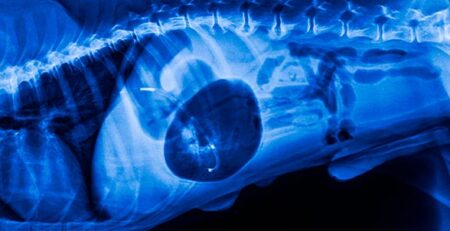Cold tail dog or cold tail i.e. when the dog does not move its tail and keeps it down because it has pain: these are the triggers of acute caudal myopathy.
Cold tail dog syndrome is a condition also known as acute caudal myopathy.
When the dog’s tail is strangely down and immobile, it is likely that it is manifesting the most obvious symptom of cold tail syndrome or cold tail.
Cold tail: how come the dog keeps its tail down
Acute caudal myopathy refers to inflammation affecting the dog’s tail muscle fibers as a result of heat shock.
The pain caused by the inflammation prevents the dog from using the muscles and tendons at the end of the spine at the tail.
The cause of cold tail in dogs is mainly related to sudden changes in temperature caused by the dog’s immersion or bathing in cold water (sea or river).
But there are other triggers as well: for example, excessive physical exercises for the dog performed in cold and wet weather conditions.
Or, confining the dog to a cramped space (kennel or a carrier that is too small) that forces the dog to assume static, incorrect, and prolonged positions.
In fact, it is no coincidence that the syndrome occurs more frequently in working, hunting, or sporting dogs such as labradors, setters, and beagles.
How long does cold tail syndrome last
The manifestation of cold tail syndrome is not related to the age of the animal and can affect the dog at any time in its life.
The tail, low and motionless, has a temperature about 2-3 ºC lower than the rest of the body due to reduced blood flow.
At the base of the hairline it appears stiff and sore, a circumstance that becomes evident if you try to manipulate it.
It is a self-limiting condition, that is, it resolves within a few days.
However, the diagnosis must be confirmed by your trusted Veterinarian since other conditions also present similar symptomatology and first among them, true tail fracture.
The treatment for cold tail in the dog
After diagnosis, treatment is basically based on absolute rest so that the tail muscles can recover.
If the veterinarian deems it appropriate, he or she may also prescribe anti-inflammatories or analgesics, which are helpful in relieving the dog’s tail pain.
Preventing cold tail dog
The tail is the extension of the dog’s spine and is frequently exposed to shock accidents or inflammation.
Since it is a critically important body part for the dog, both in movement and communication, it should always be preserved.
One way to prevent inflammation, injury, fractures and bruises is to avoid having your dog engage in excessive exertion and unrestrained play.
You can ward off cold tail syndrome by avoiding cold water baths for your dog and if necessary, thoroughly drying his tail, including his hairline.
If you notice that the gait of your dog’s tail is abnormal or if it is bent downward, contact your Veterinarian immediately for a checkup.
To refer your dog for a checkup, contact the veterinary doctors on our staff who are always available to you.
We would also like to remind you that Clinica La Veterinaria is always open h24 every day including holidays and with First Aid service from 8 pm to 8 am.











